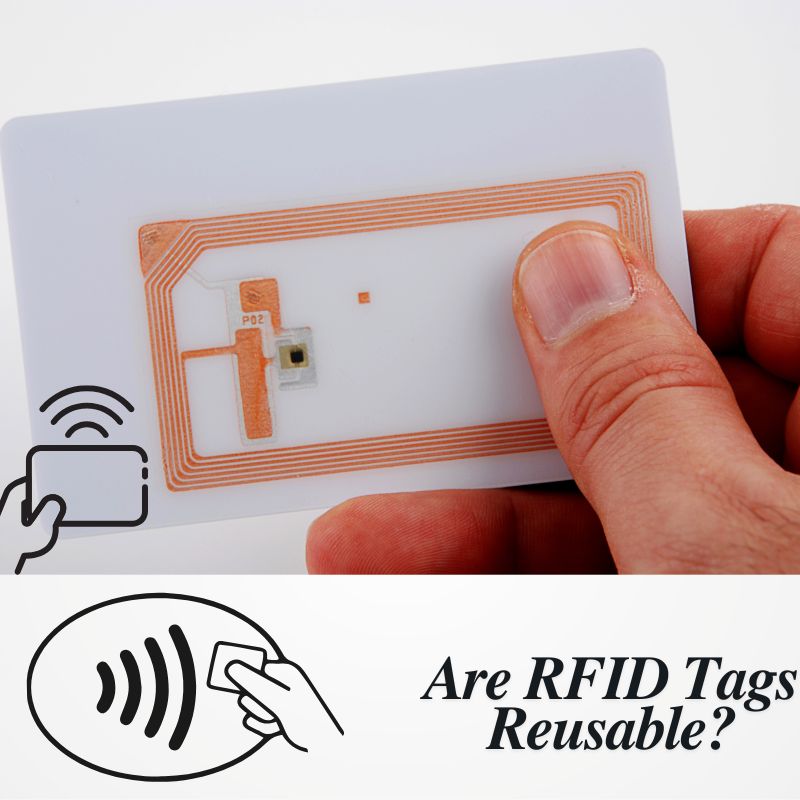
Are RFID Tags Reusable? A Practical 2025 Guide for Procurement & Operations Teams
Table of Contents
Introduction
“Are RFID tags reusable?”
The short answer:
Some RFID tags are reusable, some are disposable, and some fall in between — they can be rewritten but not physically reused.
Understanding the difference is important because it directly affects cost, ROI, operational efficiency, and sustainability strategy.
This guide explains which RFID tags can truly be reused, industry-specific recommendations, and how to evaluate whether reusable tags make financial sense for your application.

What Does "Reusable RFID" Really Mean?
There are three different concepts that are often confused:
| Type | Meaning | Example Applications |
|---|---|---|
| Reusable RFID Tag | The physical tag can be used repeatedly across multiple cycles | Laundry tags, pallet tags |
| Rewritable RFID Tag | The chip memory can be overwritten multiple times | Most UHF / HF chips |
| Disposable RFID Tag | Used once and discarded | Event wristbands, retail labels |
Are All RFID Tags Reusable?
No — only RFID tags with industrial-grade encapsulation and durability can withstand repeated use.
For example:
- A simple paper RFID label for retail products is intended for single-use.
- A UHF laundry tag for hospital linens is designed for 200–300 washing cycles.
- A pallet tag is designed for years of rotation and harsh environments
Different industries require different durability standards, and their cost structures vary widely.
Which RFID Tags Are Reusable? (By Application Industry)
UHF Laundry Tags for Industrial Laundry & Hospitals
Reusable ✔ | Rewritable ✔ | Long lifecycle
Used in:
Hotels, hospitals, uniform rental companies, food processing plants.
Designed to survive:
- 200–300+ wash cycles
- High-pressure water & squeezing
- Heat up to 200°C
- Industrial chemicals & bleach
- Mechanical friction and bending
Why are they reusable?
- PPS / Silicone / Fabric encapsulation
- Strong stitching method integrated with textiles
- Antenna & chip protected from moisture and heat
Typical ROI example
Replacing barcodes with reusable RFID laundry tags can reduce textile losses by 15–25% and labor time by 50–70% in sorting and outbound verification.
UHF Pallet Tags for Logistics & Returnable Packaging
Reusable ✔ | Rewritable ✔ | Long lifecycle
Used for:
Pallets, crates, roll cages, returnable packaging, warehouse bins.
Durability features:
- Waterproof and impact-resistant housings
- Long-range tracking up to 5–10 meters
- Screw-fixed, riveted, or adhesive-bonded mounting options
Why reusable makes sense
- Pallets circulate repeatedly
- Cost spread over hundreds of cycles
- Enables real-time asset tracking and automated logistics
Ideal for:
3PL, cold-chain logistics, manufacturing, warehouse digitalization
RFID Cable Tie Tags for Tools & Asset Management
Reusable ✘ (physical) | Rewritable ✔
Cable tie RFID tags are often mistaken for reusable tags, but they are designed as one-time tamper-evident seals.
- Once locked, they cannot be removed and reattached
- The chip can be rewritten, but the physical tag is single-use
- Ensures asset security and audit traceability
Used for:
- Construction & rental equipment
- Electric cable bundles
- Outdoor temporary infrastructure
- Industrial tools and containers
Reason for single-use:
- Prevents tampering or unauthorized removal
- Supports compliance and investigations
RFID Nail Tags for Forestry & Tree Management
Reusable (data) ✔ | Physically reusable ✘
Used for:
- Tree lifecycle tracking
- Anti-theft identification
- Plantation growth monitoring
- Digital agriculture & forestry systems
Once installed in the wood, nail tags are not removed and reused, but data can be overwritten or updated.
Reusable vs Disposable RFID Tags — Comparison Table
| Feature | Reusable RFID | One-time Cable Tie RFID | Disposable RFID |
|---|---|---|---|
| Physical reuse | ✔ | ✘ | ✘ |
| Data rewrite | ✔ | ✔ | Limited |
| Cost per unit | Higher | Medium | Low |
| Typical lifespan | Months–years | One cycle | One cycle |
| Best for | Laundry, pallets, returnable packaging | Tool sealing, security control | Events, retail, tickets |
| ROI | High | Medium | Low |
What Determines Whether an RFID Tag Can Be Reused?
To determine true reusability, evaluate these factors:
- Temperature and heat resistance
- Pressure and mechanical stress
- Chemical exposure
- Encapsulation material
- Chip memory endurance
- Waterproof rating
- Mounting method
- Frequency type (LF / HF / UHF)
Example:
UHF laundry tags are encapsulated in industrial-grade housing and stitched inside textiles, while retail labels are paper-based and designed to be removed and discarded.

Cost & ROI Considerations
Reusable RFID tags generally have a higher unit price but a lower lifecycle cost.
Illustrative ROI scenario
| Tag Type | Quantity | Cost | Lifecycle | Cost per use |
|---|---|---|---|---|
| UHF Laundry Tag | 500 pcs | $1.00 | 250 cycles | $0.004 / cycle |
| Disposable Sticker | 500 pcs | $0.12 | 1 cycle | $0.12 / cycle |
Conclusion: A reusable tag becomes more economical after 10–12 cycles.
FAQs About Reusing RFID Tags
Can RFID tags be rewritten multiple times?
Yes — most RFID chips support multiple rewrites unless locked.
Can reusable RFID survive washing and chemicals?
Industrial laundry tags are designed for this purpose and can withstand 200–300 cycles.
Are RFID tags reusable near metal or liquid?
Requires anti-metal design and proper tuning.
Which RFID tag lasts the longest?
Hard UHF industrial tags for pallets and returnable assets.
Are reusable RFID tags always cheaper long-term?
Not always — depends on replacement cycle and operational losses.
Conclusion
RFID tags can be reusable, rewritable, or disposable depending on their construction and intended purpose.
For industries such as industrial laundry, hospitals, logistics pallets, and asset tracking, reusable RFID delivers strong ROI and operational transparency.
Meanwhile, cable tie tags and retail labels remain single-use, even though their data can be rewritten.
The optimal choice depends on:
- Expected lifecycle
- Environmental conditions
- Asset value
- Cost per cycle
- Operational process
Need guidance choosing the right RFID tag for your application?
If you share your industry, application, and expected durability, I can recommend the best tag format and send sample options for testing.
Email: [email protected]
Comments
Hot Products

What Is RFID Waste Management
Imagine a city where every trash bin speaks — not literally — but through a tiny chip that tells the system when it’s full, when it’s emptied, and where it went. That’s what RFID waste management is doing today.

What are Bolt Seals and their Applications? | Complete Guide
In global trade and logistics, bolt seals play a crucial role in ensuring cargo security and compliance. These small but powerful devices are designed to lock shipping containers, trailers, and cargo doors with a tamper-evident mechanism.

What is an RFID Card Protector? Benefits, Use Cases, and Buying Guide
RFID technology (Radio Frequency Identification) is everywhere: in your credit cards, ID badges, transit passes, hotel room keys, and more. It offers speed and convenience, but it also opens the door to a new kind of digital theft called “skimming.” That’s where an RFID card protector comes in.

RFID Wristbands for Events: Bulk Buying Guide for Organizers
RFID wristbands for events are becoming the go-to solution for organizers who need faster entry, fraud prevention, and cashless payments at concerts, festivals, and sports venues. Unlike paper tickets or QR codes, these smart wristbands use embedded chips to streamline access, secure transactions, and improve the guest experience.

How RFID Tag on Windscreen Improves Vehicle Access Control and Toll Systems
In today’s fast-paced world, vehicle identification needs to be quick, secure, and contactless. An RFID Tag on the Windscreen provides exactly that — a reliable way to manage toll collection, parking, and gated access without stopping vehicles.

The Benefits of RFID Linen Tags in Commercial Laundry
Managing laundry in hospitals, hotels, or large laundry services is a big job. Each day, thousands of sheets, towels, and uniforms are washed, sorted, and sent back out. But problems like lost linens, sorting mistakes, and manual counting can cost companies a lot of money. For example, mid-sized hotels can lose over $200,000 each year from missing linens.
That’s where RFID Linen Tags come in.
Tags
RELATED BLOGS

What Is RFID Waste Management
Imagine a city where every trash bin speaks — not literally — but through a tiny chip that tells the system when it’s full, when it’s emptied, and where it went. That’s what RFID waste management is doing today.

What are Bolt Seals and their Applications? | Complete Guide
In global trade and logistics, bolt seals play a crucial role in ensuring cargo security and compliance. These small but powerful devices are designed to lock shipping containers, trailers, and cargo doors with a tamper-evident mechanism.

What is an RFID Card Protector? Benefits, Use Cases, and Buying Guide
RFID technology (Radio Frequency Identification) is everywhere: in your credit cards, ID badges, transit passes, hotel room keys, and more. It offers speed and convenience, but it also opens the door to a new kind of digital theft called “skimming.” That’s where an RFID card protector comes in.




